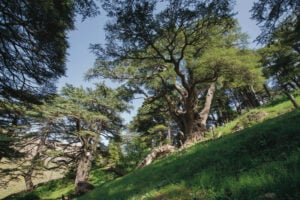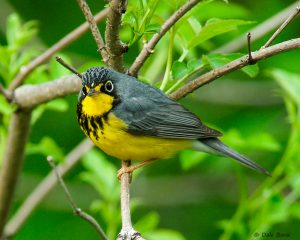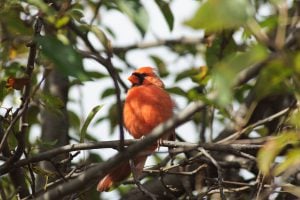The contrast between the standing dead trees and new growth is evident two months after the fire.
(Photo: Sarah Hewitt)
Foster and Christine Godwin of Owl Moon Environmental have monitored birds in the Fort McMurray area for a decade, and the fire, while devastating economically and emotionally to many, provided them a rare research opportunity. Since they had data from before the fire, they’ve been able to track the forest’s recovery using birds as indicators.
“Birds respond quickly to changes in the environment because they are not long lived,” explains Godwin. “When the habitat changes, you end up with species changes occurring very quickly, and it’s that rapid response to habitat change that makes them a great indicator species.”
Each spring, the biologists set up mist nets to catch and band birds in more than 30 monitoring sites across the region. The fire destroyed some of their sites, only burnt the undergrowth in some and left others untouched.
“Two of our sites burned really hot,” says Foster, “so the regeneration there will be from the ground up.”
The boreal forest is a fire-dependent ecosystem, with fires sweeping through almost every decade, giving them various time markers to compare to. Where the fire burnt hottest in 2016, the habitat essentially reset completely.
During the past five years, the researchers and their field assistants have spent around 1,200 hours taking an avian inventory — noting which birds return and when — at each field site, observing the regrowth of trees and looking at the state of the forest understory. They’re building a trajectory that they expect the habitat recovery to follow.
Sparrows such as the clay-coloured and Lincoln species were predictably the first to move in. These pioneer species prefer early successional habitats like forest fire debris and first-year shrub and sapling growth.
“One thing we noticed,” says Foster about the months after the fire, “was that even in the areas that burnt hot, birds were transiting through — they came back to see what was there, but didn’t stick around.” But overall, the number of bird species they banded dropped significantly in the fire’s immediate aftermath.
A year later, new growth stood out vividly against the backdrop of blackened trees, and as it progressed, the dead trees fell, building up more structure at the ground level where some birds nest. “This,” predicted Foster at the time, “should help bring the birds back in a big way.”






